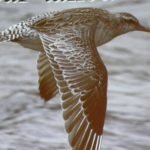Avian Angels and Devils in your Garden: Part II
Migrating Birds in Mission Hills and Elsewhere
Last September Mike Matherly told the Mission Hills Garden Club of his disappointment that the birds nesting in the stadium during the Beijing Olympics received no medals. He believes the Bar-tailed Godwit deserves a gold medal. This bird makes the longest non-stop flight of any other bird or plane.
On a particular day, thousands of Bar-tailed Godwits take off from their summer breeding grounds in Alaska. Only the adults leave; the juveniles remain in Alaska until the following September.
Eventually the birds land in New Zealand after a 7,000 mile, nine day trip across the Pacific Ocean with no snacks, no pillows; it is a no frills flight. Mike says the birds are able to rest a bit while flying by shutting off half the brain and using the active portion to navigate. After a rest, the other side takes over to give the first side a break. It is somewhat like having a pilot and co-pilot in the same brain.
In 2007 researchers fitted satellite transmitters on 16 birds at two locations in New Zealand. One of the birds, a female known as E7, flew 6,340 miles to a wetland on the North Korea-China border. She fed and rested there before continuing another 3,000 miles to Alaska. On August 30 she took off on her return trip south. Catching tailwinds enabled her to fly non-stop from Alaska to New Zealand, 7,145. She had lost 50 per cent of her body weight before she “dropped out of the sky,” Mike reported. (Not a good way to diet!)
These birds, he continued, count sunsets and sunrises, probably use the North Star, and definitely use land marks such as coastlines to help them navigate. During their average lifespan of about 20 years they will probably log over 300,000 air miles.
Baby Bar-tailed Godwits, born the prior spring, will begin the first leg of the same round trip journey without having ever done so before. Even if they fly without an adult, some atavistic instinct will guide them.
Many migrating birds return to the same garden, year after year. Some of our perennials are the White-crowned Sparrow, the Hooded Oriole, the Black-headed Grosbeak, Yellow-rumped Warbler, and the pretty Rufous Hummingbird. Migrating birds may see the lines of geologic magnetism. Older birds probably read the landscape.
An example of their navigational prowess showed in an experiment at Princeton University in New Jersey. 30 White-crowned Sparrows, 15 adults who were experienced West Coast birds and 15 neophytes, were captured and taken to the East Coast of New England. Normally they fly straight south from Alaska to Southern California and Northern Baja and then fly due north in the spring. Even though the landscape was different and they had never been in that part of the world, the adult birds managed to correct their flight pattern so they landed in their traditional spot. The juveniles flew straight south to Florida.
Many species of migrating birds will not enjoy a long avian lifespan. Climate change, urban spread, diminished open land and forests, and obstacles such as pesticides, predators, and bad luck have shrunk the Rufous Hummingbirds’ numbers from 12 million birds to 5 million in forty years.
What can we do to help these marvelous creatures? Mike urged us to make a difference by becoming involved in conservation and participating in restoration. Join an organization to protect the environment. Take individual responsibility for the environment, and advocate for issues you believe in. Learn what is here, he says. Make informed decisions so that you are voting to preserve what we have and conserve what is here. We need to tell our legislators what we want through cards, letters, and above all, our votes.
Category: Animals, Local News








